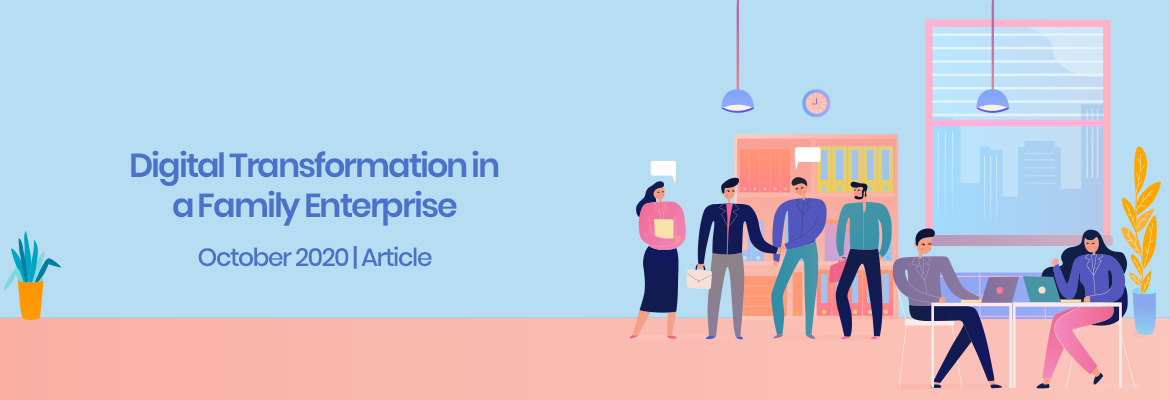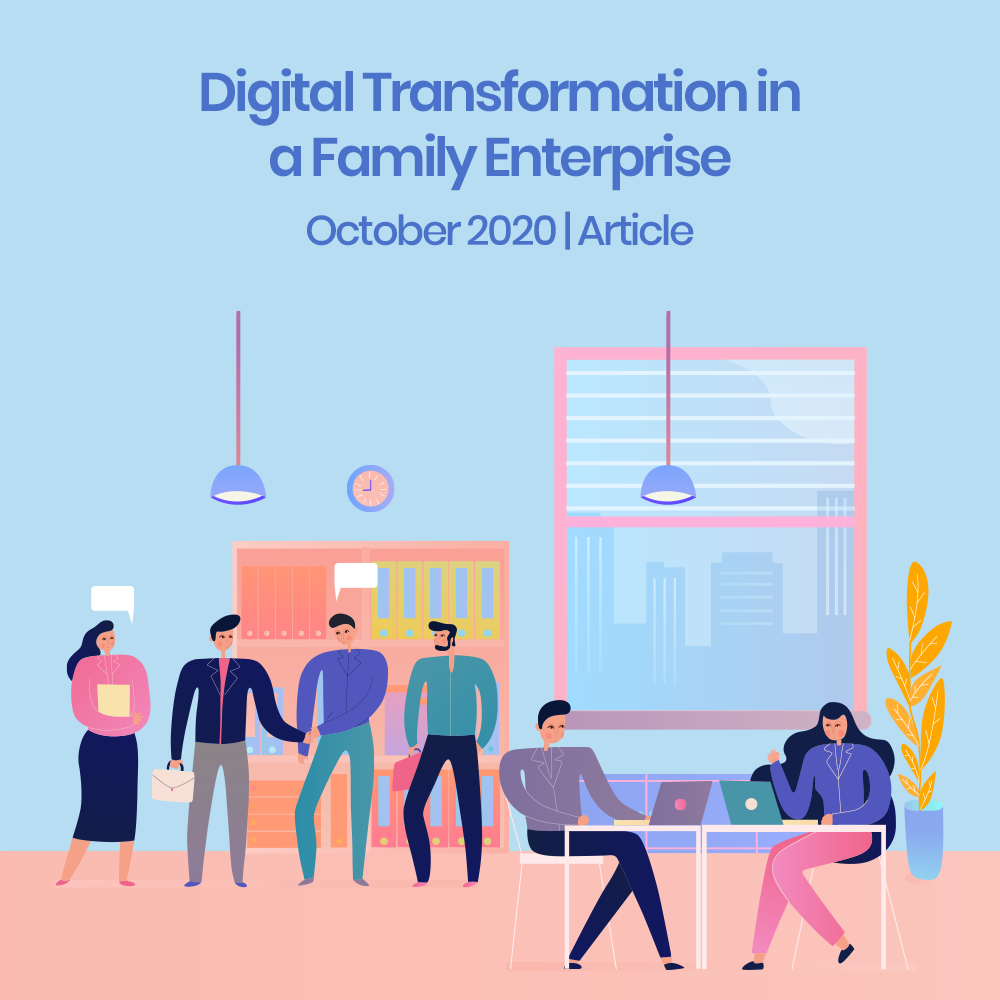

If a private business is more than 50% controlled via voting rights by a family and a public business has more than a third of its voting control with a family, they are ordinarily or conveniently considered family-owned enterprises. It is therefore no surprise that more than 70-90% of the businesses worldwide are thus classed as family businesses. The range of such family enterprises could range from the Walmarts, Swatches, LGs, and Dells of the world to the local dairy farm, national pizza chain, or a grocery store across the street.
What has worked well for family enterprises in the past?
The primary hallmark of family enterprises has usually been their ability to take swifter, smarter decisions. That has been the case because decision-making rests with those directly impacted by those very decisions and, thus, do not take those choices lightly. When these businesses pass from one generation to another, the number of next-gen shareholders might increase. Some of these next-gen end up taking an operational role, while others contend with a passive stake. As these family-owned enterprises grow in size and complexity, holding companies are formed, different classes of shares instituted, tax-favorable jurisdictions are sought, and family governance documents are inked. All these efforts are made to ensure that succession is not disruptive. All good and dandy so far.
What could go wrong for family enterprises in the future?
For family enterprises, keeping the business in the family is a keen desire, and they work hard to ensure that. That is the relatively easy part. The bigger problem lies in the fact that the business itself might die a natural death before the founder has even had a chance to pass the baton. This is because businesses are susceptible to disruption, and if an eye is not kept on keeping the business relevant, there might not be much left to handover to the next-gen. Let’s take the example of a family in the business of vinyl manufacturing in the 1950s when those vinyl records used to hold ten songs and sold for $5. Manufacturing vinyl records was a profitable business until the 1980s. However, at that time, cassettes appeared that could hold double the number of songs and sold for north of $20 apiece. If the vinyl manufacturer could start manufacturing tapes, they would survive and reap the gains from better unit economics. However, within a decade, the technology takes another quantum leap with the 1990s being ruled by CDs, which were cheaper than tapes. After that, at the turn of the century, mp3 players allowed one to have hundreds of songs in the palm of their hand, while people manufacturing tapes and CDs became relics of the past. One could maybe pivot to mass-produce mp3 players, but within a decade, music streaming went mainstream, and mp3 players became the latest technology that was ditched. Now, for $10, you can stream north of 40,000 songs. The business founder in the 1950s might have built an excellent vinyl manufacturing business and handed down a very solid business, but the next-gen, unless they had an eye to the future and agility to pivot, would be like the carriage makers at the advent of motorized vehicles. This is what happens in any business that assumes that they have competitive advantages to eternity, barriers to entry, sturdy business moats, or built to last.
Forward looking corporates have been there and done that
Digital transformation is the use of available technology to help pivot legacy/manual businesses to new/digital business models to manage employee and client expectations better while creating new experiences that are mutually rewarding. It also means that digital transformation is an ongoing process. Since the turn of this century, most corporate businesses have scrambled to transform themselves. Forward-looking corporate businesses understood the role and convenience of computers, e-commerce platforms, online payment gateways, cybersecurity, CRM software, and tech-savvy workforce that can swiftly respond to the evolving needs of their clients. They onboarded them early on and continue to lead the pack in their sectors, markets, or universes.
What Covid-19 has meant for the family enterprises resisting digital transformation
Family enterprises still had to be convinced of the importance of digital transformation. The push back to investing in tech stemmed from their inability to compute the ROI (return on investment). Being held hostage to the paralysis due to over-analysis also contributed to technology’s slow uptake rate. But then Covid-19 happened. The paperless office was a mantra that was being championed for ages, but paper was used liberally even in the day and age of email prevalence. Work from home has probably put the final nail in the coffin of the pointless printing that goes on in most offices. If you are in the family business of paper manufacturing, not paying heed to where the industry might be heading can have the inevitable consequence of being left behind forever. The same goes for those plying their trades in traditional advertising or F&B outlets resisting food aggregators, for example. Virtual work, virtual studies, virtual socializing, telemedicine, etc. have all contributed to a rethink for those family enterprises resisting digital transformation in their offerings. They are now waking up to see what the absence of technological offering and meaningful digital footprint could do or is already adversely doing to their business.
A family enterprise in the construction business not interested in hearing about 3D printing is only digging their own grave. A family enterprise present in making surgical equipment believing IoT devices not to be their line of work will be in for a heartbreak. A family enterprise in the fossil fuel-based industry may become dated before the decade is done. A family running a dairy farm but thinking robots milking cows or cow collars providing data analytics is in the realm of science fiction will soon cry over spilled milk. As a silver lining out of the 2020 pandemic, digital transformation now stands accelerated. Covid-19 is not just disastrous to personal health, but also business health, as it is accelerating the survival risk of family enterprises. Vaccines will help blunt the attack on personal health. Digital transformation will help revitalize corporate health.
Family enterprises have reimagined business models for centuries
We all know the ways the tech giants of today reimagined business models on the go. Google was a search engine company with no viable business model until it hit upon AdWords and today can be mistaken for an advertising company. PayPal started as a cryptography company, while no one could imagine Amazon, which sold books online, would shape our e-commerce shopping habits. It is all about being agile with ones operating models and taking risks with pivoting. However, this playbook of reimagining business models was perfected by forward-looking family enterprises over decades and centuries. Let’s take the case of Lego. Lego started as a wooden toy maker and then a maker of plastic toy bricks when wood sourcing became costly and difficult. Even the charm of plastic toy bricks melted away until they pivoted to add tech to something as banal as a plastic brick. They collaborated with Harry Potter, Star Wars and other franchises and have now even rolled out their own movies. Technology has led them to reinvent themselves every few decades, thanks to their receptiveness to reimagining their business model.
Reimagining business models today however means embracing digital transformation
It is hard to imagine, but Tiffany started as a stationery brand before finding its shine in luxury jewelry. It is a long story, but if you can take my word for it, Nokia started as a paper mill, and Berkshire Hathaway was originally a textile mill. None of those pivots was about technology. Reimagining business models in the past had more to do with differentiation, diversification, or divestment. Product mix, geographical coverage, M&A, etc. ranked highly in the tools at one’s disposal when looking at reimaging business models. Today, however, reimagining business models start by embracing digital transformation. That has to be the number one consideration, and everything else starts a notch below this. Once digital transformation gets to be the number one consideration, all other business decisions can be made from that lens. M&A, product lifecycles, geographical expansions, etc. can now be done, less on whim and more on data analytics and meaningful information. Gut and hunch can finally play a secondary role in meaningful business insights gleaned from hundreds of variables in an actionable format. Digital transformation gives businesses those opportunities that were unthinkable earlier. As an enabler for new business models, digital transformation fundamentally changes how corporations operate and deliver value to their clients.
M&A, product lifecycles, geographical expansions, etc. can now be done, less on whim and more on data analytics and meaningful information. Gut and hunch can finally play a secondary role in meaningful business insights gleaned from hundreds of variables in an actionable format. Digital transformation gives businesses those opportunities that were unthinkable earlier. As an enabler for new business models, digital transformation fundamentally changes how corporations operate and deliver value to their clients.
When Microsoft, the granddaddy of technology, went on a digital transformation journey in 2014 by focusing on the cloud, it’s hard to imagine that it achieved the trillion-dollar market cap ahead of Google in 2019. How’s that for it never being too late to pivot? Selling shoes is as dull as it can get, but when Nike realized that they were tripping, they embraced the digital transformation journey by investing in e-commerce, consumer engagement, digital campaigns, and the financial results have vastly outweighed the investment. Thanks to the digital transformation that Covid-19 has accelerated, we will not balk when we hear about robots joining us as work colleagues, dentists sending us Zoom links for initial inspections, or grocery shopping by clicking on potatoes and onions online. Of course, on the other end, those businesses will have to enable that environment to make those experiences recurring.
How family enterprises are embracing digital transformation
- Digital communication with family members: Family enterprises are now deploying communication platforms that enable timely dissemination of information across all branches of the family and stakeholders at the same time to reduce any information arbitrage. Internal WhatsApp groups have leapfrogged the traditional email as a medium of communication. However, today offerings like Trusted Family or Diligent are becoming the new ways for communication. Coupled with offerings like DocuSign, it’s easy to see that the old ways of doing things are clearly on the way out.
- Digital footprint: Family enterprises who scoffed at even having a website in the past have realized that being off the internet does them no favors anymore. In fact, they have embraced social media to shape their narrative instead of being at the passive end of the plot being dictated by others. An article by yours truly on how senior members of the family enterprise can utilize social media can be found here.
- Guided by analytics instead of the gut: Family enterprises have been guilty of coining the phrase, ‘this is how we have always done it around here.’ However, after embracing data transformation and the amount of data and information being churned thanks to that digital pivot, being guided by data is going mainstream. One very practical outcome of this that I have seen is dynamic pricing, which would not have been possible without the benefit of embracing digital transformation.
- Enabling consultants: Family enterprises have finally found a reason to engage consultants. Traditionally, they had relied on insider knowledge as their secret sauce to making big decisions. Digital transformation is a pivot into a new normal that requires solid handholding from credible advisors who have a macro view on the landscape and can deploy specialist toolkits to provide tailor-made solutions. Outfits like TransformX have positioned themselves well to be the first port of call in that engagement, enablement, and engagement transformational journey.
- Cloud: Family enterprises had an excessive obsession with data privacy concerns and felt that physical networks in server rooms, in the dark recesses of the corporate basement was the way to go. Family enterprises have, however, now realized that the best BCP plan or disaster recovery scenario stands crippled in the face of curfews or lockdowns. Cloud is being embraced and not just for its convenience but also its cost-effectiveness, synchronization, and security.
- Sandboxing digital initiatives: Family enterprises could be nervous about letting the next-gen tinker with established product lines. Next-gen may not be amused with the legacy offerings. Digital transformation allows creating a sandbox environment, where legacy products can be replicated and tinkered with, in a digital environment, before they are ready to be released in the real world with a tech wrapper. Thanks to those sandboxing initiatives, family enterprises have rolled out virtual food brands or created sales channels on unlikely platforms like Instagram. With this and other means such as digital twinning, family enterprises have, thus, created a culture of innovation and incubation by embracing digital transformation.
Conclusion
The shift to digital is no longer optional. Just buying hardware or passing a shareholder resolution approving the IT strategy will not cut it anymore. Family enterprises, who are the backbone of any economy, are doing a lot of exploiting (“thinking outside the box”) and exploring (“thinking without the box”), and we will all be beneficiaries of it the more the conversation about digital transformation goes mainstream. Timely intervention with consultants/experts in lending a hand to enabling organizations find their feet in this fast-evolving landscape is possibly the first step in the right direction. This then leads to adopting a digital strategy, and one goes on from there on the inevitable journey of digital transformation that the pandemic has accelerated. As they say, the first step towards getting somewhere is to decide you are not going to stay where you are.
Bon voyage!
About the Author
Asher Noor is the Chief Investment Officer for AlTouq Group, a Saudi-Arabian based single-family office. The views expressed in this article are his own. He can be reached at asher@altouq.com
LinkedIn: www.linkedin.com/in/ashernoor/
If a private business is more than 50% controlled via voting rights by a family and a public business has more than a third of its voting control with a family, they are ordinarily or conveniently considered family-owned enterprises. It is therefore no surprise that more than 70-90% of the businesses worldwide are thus classed as family businesses. The range of such family enterprises could range from the Walmarts, Swatches, LGs, and Dells of the world to the local dairy farm, national pizza chain, or a grocery store across the street.
What has worked well for family enterprises in the past?
The primary hallmark of family enterprises has usually been their ability to take swifter, smarter decisions. That has been the case because decision-making rests with those directly impacted by those very decisions and, thus, do not take those choices lightly. When these businesses pass from one generation to another, the number of next-gen shareholders might increase. Some of these next-gen end up taking an operational role, while others contend with a passive stake. As these family-owned enterprises grow in size and complexity, holding companies are formed, different classes of shares instituted, tax-favorable jurisdictions are sought, and family governance documents are inked. All these efforts are made to ensure that succession is not disruptive. All good and dandy so far.
What could go wrong for family enterprises in the future?
For family enterprises, keeping the business in the family is a keen desire, and they work hard to ensure that. That is the relatively easy part. The bigger problem lies in the fact that the business itself might die a natural death before the founder has even had a chance to pass the baton. This is because businesses are susceptible to disruption, and if an eye is not kept on keeping the business relevant, there might not be much left to handover to the next-gen. Let’s take the example of a family in the business of vinyl manufacturing in the 1950s when those vinyl records used to hold ten songs and sold for $5. Manufacturing vinyl records was a profitable business until the 1980s. However, at that time, cassettes appeared that could hold double the number of songs and sold for north of $20 apiece. If the vinyl manufacturer could start manufacturing tapes, they would survive and reap the gains from better unit economics. However, within a decade, the technology takes another quantum leap with the 1990s being ruled by CDs, which were cheaper than tapes. After that, at the turn of the century, mp3 players allowed one to have hundreds of songs in the palm of their hand, while people manufacturing tapes and CDs became relics of the past. One could maybe pivot to mass-produce mp3 players, but within a decade, music streaming went mainstream, and mp3 players became the latest technology that was ditched. Now, for $10, you can stream north of 40,000 songs. The business founder in the 1950s might have built an excellent vinyl manufacturing business and handed down a very solid business, but the next-gen, unless they had an eye to the future and agility to pivot, would be like the carriage makers at the advent of motorized vehicles. This is what happens in any business that assumes that they have competitive advantages to eternity, barriers to entry, sturdy business moats, or built to last.
Forward looking corporates have been there and done that
Digital transformation is the use of available technology to help pivot legacy/manual businesses to new/digital business models to manage employee and client expectations better while creating new experiences that are mutually rewarding. It also means that digital transformation is an ongoing process. Since the turn of this century, most corporate businesses have scrambled to transform themselves. Forward-looking corporate businesses understood the role and convenience of computers, e-commerce platforms, online payment gateways, cybersecurity, CRM software, and tech-savvy workforce that can swiftly respond to the evolving needs of their clients. They onboarded them early on and continue to lead the pack in their sectors, markets, or universes.
What Covid-19 has meant for the family enterprises resisting digital transformation
Family enterprises still had to be convinced of the importance of digital transformation. The push back to investing in tech stemmed from their inability to compute the ROI (return on investment). Being held hostage to the paralysis due to over-analysis also contributed to technology’s slow uptake rate. But then Covid-19 happened. The paperless office was a mantra that was being championed for ages, but paper was used liberally even in the day and age of email prevalence. Work from home has probably put the final nail in the coffin of the pointless printing that goes on in most offices. If you are in the family business of paper manufacturing, not paying heed to where the industry might be heading can have the inevitable consequence of being left behind forever. The same goes for those plying their trades in traditional advertising or F&B outlets resisting food aggregators, for example. Virtual work, virtual studies, virtual socializing, telemedicine, etc. have all contributed to a rethink for those family enterprises resisting digital transformation in their offerings. They are now waking up to see what the absence of technological offering and meaningful digital footprint could do or is already adversely doing to their business.
A family enterprise in the construction business not interested in hearing about 3D printing is only digging their own grave. A family enterprise present in making surgical equipment believing IoT devices not to be their line of work will be in for a heartbreak. A family enterprise in the fossil fuel-based industry may become dated before the decade is done. A family running a dairy farm but thinking robots milking cows or cow collars providing data analytics is in the realm of science fiction will soon cry over spilled milk. As a silver lining out of the 2020 pandemic, digital transformation now stands accelerated. Covid-19 is not just disastrous to personal health, but also business health, as it is accelerating the survival risk of family enterprises. Vaccines will help blunt the attack on personal health. Digital transformation will help revitalize corporate health.
Family enterprises have reimagined business models for centuries
We all know the ways the tech giants of today reimagined business models on the go. Google was a search engine company with no viable business model until it hit upon AdWords and today can be mistaken for an advertising company. PayPal started as a cryptography company, while no one could imagine Amazon, which sold books online, would shape our e-commerce shopping habits. It is all about being agile with ones operating models and taking risks with pivoting. However, this playbook of reimagining business models was perfected by forward-looking family enterprises over decades and centuries. Let’s take the case of Lego. Lego started as a wooden toy maker and then a maker of plastic toy bricks when wood sourcing became costly and difficult. Even the charm of plastic toy bricks melted away until they pivoted to add tech to something as banal as a plastic brick. They collaborated with Harry Potter, Star Wars and other franchises and have now even rolled out their own movies. Technology has led them to reinvent themselves every few decades, thanks to their receptiveness to reimagining their business model.
Reimagining business models today however means embracing digital transformation
It is hard to imagine, but Tiffany started as a stationery brand before finding its shine in luxury jewelry. It is a long story, but if you can take my word for it, Nokia started as a paper mill, and Berkshire Hathaway was originally a textile mill. None of those pivots was about technology. Reimagining business models in the past had more to do with differentiation, diversification, or divestment. Product mix, geographical coverage, M&A, etc. ranked highly in the tools at one’s disposal when looking at reimaging business models. Today, however, reimagining business models start by embracing digital transformation. That has to be the number one consideration, and everything else starts a notch below this. Once digital transformation gets to be the number one consideration, all other business decisions can be made from that lens. M&A, product lifecycles, geographical expansions, etc. can now be done, less on whim and more on data analytics and meaningful information. Gut and hunch can finally play a secondary role in meaningful business insights gleaned from hundreds of variables in an actionable format. Digital transformation gives businesses those opportunities that were unthinkable earlier. As an enabler for new business models, digital transformation fundamentally changes how corporations operate and deliver value to their clients.

When Microsoft, the granddaddy of technology, went on a digital transformation journey in 2014 by focusing on the cloud, it’s hard to imagine that it achieved the trillion-dollar market cap ahead of Google in 2019. How’s that for it never being too late to pivot? Selling shoes is as dull as it can get, but when Nike realized that they were tripping, they embraced the digital transformation journey by investing in e-commerce, consumer engagement, digital campaigns, and the financial results have vastly outweighed the investment. Thanks to the digital transformation that Covid-19 has accelerated, we will not balk when we hear about robots joining us as work colleagues, dentists sending us Zoom links for initial inspections, or grocery shopping by clicking on potatoes and onions online. Of course, on the other end, those businesses will have to enable that environment to make those experiences recurring.
How family enterprises are embracing digital transformation
- Digital communication with family members: Family enterprises are now deploying communication platforms that enable timely dissemination of information across all branches of the family and stakeholders at the same time to reduce any information arbitrage. Internal WhatsApp groups have leapfrogged the traditional email as a medium of communication. However, today offerings like Trusted Family or Diligent are becoming the new ways for communication. Coupled with offerings like DocuSign, it’s easy to see that the old ways of doing things are clearly on the way out.
- Digital footprint: Family enterprises who scoffed at even having a website in the past have realized that being off the internet does them no favors anymore. In fact, they have embraced social media to shape their narrative instead of being at the passive end of the plot being dictated by others. An article by yours truly on how senior members of the family enterprise can utilize social media can be found here.
- Guided by analytics instead of the gut: Family enterprises have been guilty of coining the phrase, ‘this is how we have always done it around here.’ However, after embracing data transformation and the amount of data and information being churned thanks to that digital pivot, being guided by data is going mainstream. One very practical outcome of this that I have seen is dynamic pricing, which would not have been possible without the benefit of embracing digital transformation.
- Enabling consultants: Family enterprises have finally found a reason to engage consultants. Traditionally, they had relied on insider knowledge as their secret sauce to making big decisions. Digital transformation is a pivot into a new normal that requires solid handholding from credible advisors who have a macro view on the landscape and can deploy specialist toolkits to provide tailor-made solutions. Outfits like TransformX have positioned themselves well to be the first port of call in that engagement, enablement, and engagement transformational journey.
- Cloud: Family enterprises had an excessive obsession with data privacy concerns and felt that physical networks in server rooms, in the dark recesses of the corporate basement was the way to go. Family enterprises have, however, now realized that the best BCP plan or disaster recovery scenario stands crippled in the face of curfews or lockdowns. Cloud is being embraced and not just for its convenience but also its cost-effectiveness, synchronization, and security.
- Sandboxing digital initiatives: Family enterprises could be nervous about letting the next-gen tinker with established product lines. Next-gen may not be amused with the legacy offerings. Digital transformation allows creating a sandbox environment, where legacy products can be replicated and tinkered with, in a digital environment, before they are ready to be released in the real world with a tech wrapper. Thanks to those sandboxing initiatives, family enterprises have rolled out virtual food brands or created sales channels on unlikely platforms like Instagram. With this and other means such as digital twinning, family enterprises have, thus, created a culture of innovation and incubation by embracing digital transformation.
Conclusion
The shift to digital is no longer optional. Just buying hardware or passing a shareholder resolution approving the IT strategy will not cut it anymore. Family enterprises, who are the backbone of any economy, are doing a lot of exploiting (“thinking outside the box”) and exploring (“thinking without the box”), and we will all be beneficiaries of it the more the conversation about digital transformation goes mainstream. Timely intervention with consultants/experts in lending a hand to enabling organizations find their feet in this fast-evolving landscape is possibly the first step in the right direction. This then leads to adopting a digital strategy, and one goes on from there on the inevitable journey of digital transformation that the pandemic has accelerated. As they say, the first step towards getting somewhere is to decide you are not going to stay where you are.
Bon voyage!
About the Author
Asher Noor is the Chief Investment Officer for AlTouq Group, a Saudi-Arabian based single-family office. The views expressed in this article are his own. He can be reached at asher@altouq.com
LinkedIn: www.linkedin.com/in/ashernoor/




